Introduction
Prior to the closure of the ACES studio in 2009, Microsoft
successfully tempted eager flight simulation fans for decades
with revolutionary new editions of the popular software every 2
years or so. Every new release provided something new; MSFS 4.0
(developed in 1989) detached the two dimensional stigma of the
series by introducing dynamic scenery for the first time, whilst
MSFS 98 (1997) featured the first ever helicopter (Bell 206
Jetranger) within the simulator.
It was not until the release of MSFS 2002, however, that any
form of Air Traffic Control (ATC) facility was developed. In
fact, MSFS 2002 also featured the first ever Artificial
Intelligence (AI) aircraft within the series; it was now
possible to fight over takeoff clearances, race for parking
spots and purposefully incur the wrath of ATC by cruising just a
few centimetres away from another aircraft!
Despite the hype, Microsoft’s ATC system came as a
disappointment for serious pilots and realism-craving simmers.
SIDs and STARs were virtually non-existent, it was impossible to
accurately report emergency situations and ATC would often
become confused; it was not uncommon to see frequent runway
collisions, neither was it unusual to have ATC simply “forget”
about you and leave you to fly straight into a mountain in
IMC-rated conditions.
Indeed, even the final release of MSFS (FSX) did not show any
significant improvement. The execution of the MSFS series in
2009 seemed to seal the fate for ATC fanatics; they were left
with a rather unrealistic, basic system that did not cater for
their needs. Their luck, however, was about to change...

VoxATC is an air traffic control extension product for
Microsoft’s FSX. The software provides such a significant revamp
of ATC facilities that the term “extension” may be a little
inaccurate; absolutely all of the sub-standard default systems
have been removed, and replaced with modern, up-to-date air
traffic control service that is suitable for both VFR and IFR
pilots.
Unique in its nature, VoxATC has been specifically designed with
PPL (Private Pilot’s Licence) and IMC training pilots
(Instrument Meteorological Conditions) in mind. One of the
program’s lead developers, Bob Sidwick, is an experienced pilot
who has held an instrument rating for many years; proving that
the software is indeed as realistic as possible.
The CAA (Civil Aviation Authority) regularly reviews and adjusts
ATC procedures as appropriate. In 2009, a major overhaul of ATC
services took place (mainly due to a RAF ATC incident). This
changed a large proportion of ATC calls; whilst some new ATSOCAS
Services (Air Traffic Services Outside Controlled Airspace;
services that are used predominantly on VFR cross-country
flights) were also introduced. This meant that FSX’s already
outdated ATC system seemed even more out of place, and so PPL
pilots used MSFS as a training aid would have been severely
confused.
Luckily, VoxATC has been developed in close contact
with the latest version of the Radiotelephony Manual CAP413
published by the CAA; meaning that anything practiced using
VoxATC is current and appropriate.
The most outstanding feature of VoxATC, one that allows it to be
placed in a totally different league to any other ATC program,
is that of voice recognition. The word “Vox” itself hints that
one’s voice may be involved, and the software does not
disappoint. Every single plausible ATC phrase can be spoken into
a microphone and then interpreted by the software, followed by
an appropriate reply from the program’s air traffic
controller(s).
Should you be unable to acknowledge a takeoff clearance
properly, or unable to accurately recall the current QNH, the
program will instantaneously criticise your unsuitable
phraseology – features that no other ATC software system can
provide.
VoxATC also provides custom AI aircraft which are controlled
using the software. These AI aircraft are much more intelligent
and realistic than the default AI models, and operate totally
separately from any of FSX’s own AI aircraft. The ability to
generate and control its own traffic allows VoxATC to qualify as
a “2 in 1” product; both a traffic program AND a groundbreaking
new ATC system are provided with each purchase!
Software Features and Purchase
Information
VoxATC 6 can be purchased from RC Simulations' shop for £44.99.
This will provide you with a registration key which can be
entered and activated internally within the program. It is
important to note that the actual software download is free
(with a 7 day trial); and that the registration key is entered
into this “free download”.
A boxed version of VoxATC is also available upon special request
from RC Simulations, and can also be purchased from
Flighstore.co.uk for £84.95.
Upon face value, £44.99 may seem very expensive for FSX
software. It is very important to consider, however, that you
are essentially purchasing a traffic program AND a realistic ATC
system in one. The overall cost therefore will actually be
significantly lower than if purchasing a traffic expansion and
an ATC program separately.
Since VoxATC is professional ATC software, designed to replicate
real-world procedures with maximum realism, it does not “go
light” on features. The software boasts the following features:
| • Totally voice-recognition powered ATC system; air traffic control listen to what you say and will recognise any mistakes you may make | |
| • All procedures/calls are developed using CAP413; the official CAA Radiotelephony manual | |
| • A completely new traffic system; VoxATC adds its own traffic separate to that of FSX's default traffic, which follow any instructions given by air traffic controllers | |
| • Extensive coverage of all VFR/IFR procedures; VoxATC can be used as a real-world training aid | |
| • “Strict” air traffic control; incorrect read back of a clearance or a failure to follow taxi instructions will result in interrogation by ATC | |
| • Configurable ATC voices; both speed and “voice type” (ie choosing from multiple peoples' voices) can be configured | |
| • Extra programs (provided with VoxATC) allow for things such as runway numbers and taxiway markings to be updated; allowing the ATC experience to be as up-to-date and current as possible |
RCSimulations has also been able to provide a £20.00 discount to owners of the previous version of VoxATC (VoxATC 5). To obtain this discount, the registration code for Version 5 should be entered when ordering VoxATC 6.
Getting Started – Installation
and Set Up
VoxATC's installation process is painfully simple. After running
the executable file provided with the download (or on the CD),
simply follow the on-screen instructions. At a certain point in
the installation, the registration key, found within the CD case
(or within purchase information if a download) will be
requested; entering this in will “activate” VoxATC.
Once installed, the most vital step to getting started with
VoxATC is to configure Windows Speech Recognition. This is
because VoxATC relies upon speech recognition to understand and
interpret voice inputs from the user. The first step is to go
your operating system's speech recognition control panel. This
is a similar but visually different interface depending on
whether you are running Windows XP, Vista or Windows-7. This
review is written from a perspective of someone using Windows-7.
From the start menu, type “speech” into the program search bar.
There will be an option named “Change text to speech settings”.
Clicking on this option will bring up an interface like this:
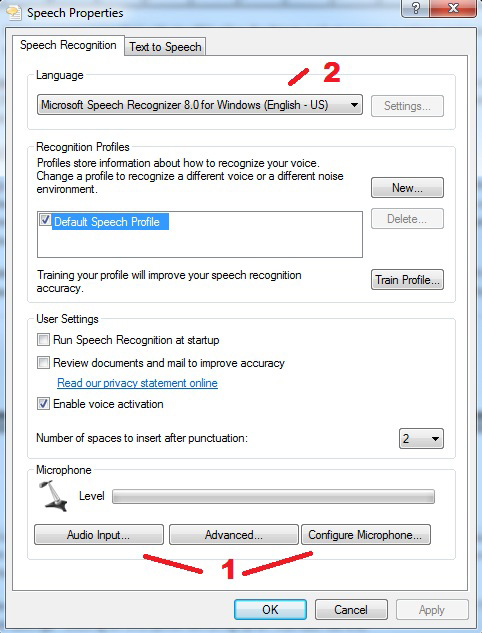
The above screen shots shows the exact settings that should be
used when configuring VoxATC. The most important aspects have
been labelled; the number “1” represents the microphone options,
whilst number “2” shows that the language should be set to
English (either UK or US English). The “configure microphone”
button (labelled as “1”), if clicked, will bring up an
interactive wizard that enables voice recognition to understand
your voice. This wizard should be followed as carefully as
possible in order to get the best voice recognition.
The “audio input” button allows the user to choose which
microphone they are using as the input source. This may seem
rather self explanatory, however, for someone like myself, who
has 6 different microphone inputs going into one PC, it is
paramount that this is configured correctly.
Personally, I am using a Saitek Pro Flight Headset with my FSX
setup. I find that headset microphones are best for voice
recognition purposes, however you may use other microphones
provided that they process audio at a suitable enough quality.
Once the Windows speech recognition system has been correctly
set up, the next step is to run the VoxATC indexing tool. The
indexing tool provides VoxATC with an up-to-date overview of all
the airports, runways and taxiways; therefore allowing for the
correct operation of ATC. For example, the default Heathrow
(EGLL) airport will be different to Aerosoft's Mega Heathrow
airport (ie a few taxiways and parking spots will be displaced);
and so it is very important that VoxATC has a “map” of the
“correct” Heathrow airport, to prevent itself from telling you
to taxi into a building!
The run the indexing tool, simply start the executable file
named “VoxATC Indexer” located in the VoxATC folder. Starting
the program will immediately begin the process (which takes
around 5 minutes, depending on the amount of add-ons installed).
Please note, ALL scenery add-ons must be installed prior to
indexing. Should you want to install a new add-on, you will need
to re-run the indexer to allow it to keep up-to-date with FSX's
scenery library.
Now that the scenery library has been indexed by VoxATC, the
final step is to install the “VoxATC Panel” into your FSX
aircraft. The “VoxATC Panel” is a pop-up instrument panel
(accessible through the “alt” menu like all other instrument
panels), and is the actual ATC window for VoxATC.
To install the
VoxATC Panel, simply start the program named “Panel Setup” in
the VoxATC folder. From here, tick all of the aircraft you wish
to install the panel into, and then hit “install”. It is
important to note than you can only use VoxATC with an aircraft
that has the VoxATC panel installed into it.
That's all! Once all of the above steps have been completed, one
is ready to start FSX and begin using VoxATC.
Using VoxATC
Once one has started FSX, the first step, after loading a flight
of course, is to open up the VoxATC panel. This can by done by
pressing “alt”, clicking “view”, and then selecting the “VoxATC
Panel” through the “instrument panel” drop down menu.
This will bring up a window, similar in visual appearance to the
FSX ATC window.
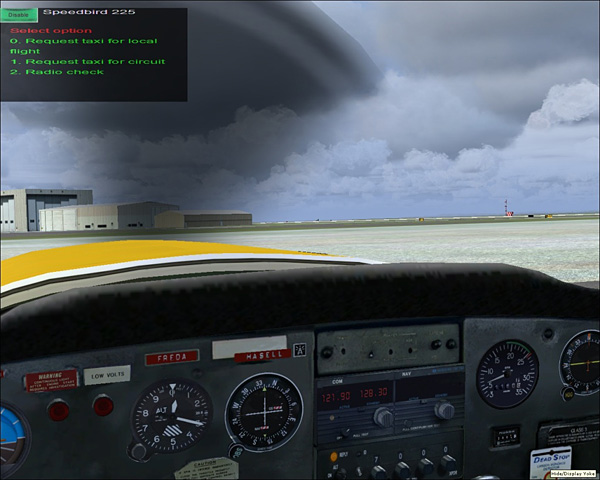 q
q
The green “enable” button in the top left corner will activate
VoxATC. Once clicked, the program will frequently blurt out the
word “test” for about 5 seconds as it initialises itself. The
self-initialisation process is complete when one hears the words
“VoxATC Version 6.0”.
After VoxATC has started, the user will be asked to tune to a
specific frequency. This is usually the frequency of the airport
in which the aircraft is situated; for example, starting a
flight at Netherthorpe (EGNF) will prompt a message of “Tune to
frequency 123.275”.
After the appropriate frequency has been selected, it is time to
make your first call with VoxATC! In accordance with real-world
procedure, the pilot establishes communications with ATC through
what is known as a “radio check”. The radio check assesses
numerous things; firstly, if ATC can hear you, secondly, if you
can hear them, and thirdly, how readable each party's
transmission is. The conversation will usually run thus,
assuming one's call-sign is G-PHLY, and assuming one is
contacting Netherthorpe Radio:
Aircraft: Netherthorpe Radio G-PHLY
request radio check 123.275
Netherthorpe Radio:G-PHLY readability
5 on 123.275
Aircraft: Readability 5 also G-PHLY
Call-signs such as “G-PHLY” are pronounced like
“Golf-Papa-Hotel-Lima-Yankee”. This is because, in aviation, the
phonetic alphabet is used instead of just ordinary letters, to
allow pilots to distinguish between similar sounding characters
(for example, “D” could sound like “E” or “C” over a poor
quality radio). Furthermore, the phrase “Netherthorpe Radio”
means that we are communicating with an A/G Radio Station; a
specific type of ATC information service (see section below).
Although it will have become obvious by this stage, it is
important to note that all transmissions are written, in text
form, on screen. This is useful if you cannot remember the exact
phraseology for a specific request, as both what you should say
and what ATC have said will appear within the VoxATC window.
This feature also ensures that you use the correct phraseology;
VoxATC builds good habits from the start!
Since there are many different ATC services and different flight
categories (VFR and IFR), the following sections of the review
have been divided into each individual service to allow for a
more detailed review of VoxATC's features.
Please note, some technical terms used in the following few
sections may be difficult to understand; likewise, the structure
of some sentences may come across as rather chiastic (inverted
grammar). I have done my best to explain complicated areas of
ATC as best as possible; I apologise if some parts are still
difficult to decipher!
VFR Flights – ATSOCAS Services
VFR, standing for Visual Flight Rules, are a group of rules that
a pilot can elect to fly by if the weather is above the required
minima. As the name suggests, VFR fight is entirely “visual”,
and a pilot can only elect to fly VFR if the weather is good
enough; more specifically:
• The Pilot must have at least 8km visibility distance (imagine
a circle with a radius of 8km, with the aircraft at the centre.
This is
the “circle
of visibility”)
• The Pilot must be in sight with the ground at all times
• The Aircraft must be clear from cloud; a distance of 1000ft
vertically, and 1,500ft horizontally
• The Pilot cannot enter Class A airspace under any
circumstances
Please note that the above conditions are just rough guidelines.
There are other factors, such as whether the pilot is flying in
controlled airspace, or whether the pilot is above 10,000ft
(FL100). For most general aviation VFR flight, however, the
above minima are suitable.
An example of such a VFR flight would be taking a Cessna 150 out
for a cross country flight between two small aerodromes. Should
the weather be good enough, the pilot will be able to perform
his flight under VFR.
VoxATC offers nearly all of the services you’d expect on a
standard real-life VFR flight (and some you wouldn’t!). The
services covered in this section are the “ATSOCAS” services, or
the “Air Traffic Services Outside Controlled Airspace”. These
services should only be used outside controlled airspace
(usually the airspace between two airfields if flying in a
relatively sparse area).
The ATSOCAS services are a set of four different types of ATC
service, designed to maintain “the safe and efficient conduct of
flight” (the latter quote is something that you will see
repeated frequently throughout the CAP413 document). A pilot
will almost always use some sort of ATSOCAS service on a VFR
flight, since they are easy to access and useful for safe
flight. The four categories are as follows:
• The Basic Service
• The Traffic Service
• The Procedural Service
• The Deconfliction Service
Although it would be a waste of time to lament on the exact
details of each service, the following should give you a rough
idea of what each service does.
The Basic Service – This is, as the name
suggests, a “basic” information service. Basically (if you’ll
pardon the pun), ATC will pass you any relevant information
useful for your flight (ie, if you’re flying near a gliding
site, ATC might give you some information on the activities
taking place there). There is no form of radar surveillance or
ATC commands involved with the basic service.
The Traffic Service – Designed as a “step up”
from the basic service, the traffic service offers the same
useful information as a basic service, whilst also providing
radar assistance in the form of traffic alerts. This means, in a
nutshell, that ATC are able to accurately report on the traffic
surrounding you using their radar equipment.
No mandatory instructions are issued, however ATC may issue
headings or altitudes for “sequencing or positioning”.
The Deconfliction Service – The most “thorough”
service. ATC use radar to track your flight and other traffic
around you, and will provide instructions for you if they
believe that you will collide with another aircraft. The
services provided in the basic and traffic services are also
included, however the difference is that the air traffic
controller will issue you with headings or altitudes to prevent
a collision.
The Procedural Service – Essentially, the
procedural service is the same as the deconfliction service,
however it is conducted without the use of radar. The air
traffic controller relies upon pilot reports so that he/she can
plot the position of aircraft in the area, and will issue the
pilot with heading/altitude advice if he believes there is a
potential collision.
VoxATC provides the user with a fully fledged basic, traffic and
deconfliction service. Unfortunately, there is no procedural
service included with VoxATC, however, in retrospect; the
service is rarely used on a day-to-day basis in real life.
All of the ATSOCAS services provided with VoxATC are fantastic.
The phraseology is, as expected, spot on, and VoxATC will
require the repetition of certain elements of your message to
ATC should you miss something out. For example, a standard
request for a basic service would be as follows (for an aircraft
with call sign G-PHLY to Waddington Radar):
Aircraft: Waddington Radar
G-PHLY
C-150
Departed Airfield X
Destination Airfield Z
Current Position Overhead Y
Altitude 2,000ft
(Extra Information, eg: “VFR”, “2 POB” (Persons on Board), etc)
Request Basic Service
The most impressive aspect of requesting these services is
that VoxATC lists them in a very specific order (as annotated above).
The application of this very precise word order is fantastic, as
it is the exact order that flight instructors tell students to
make their ATC calls. This further proves how VoxATC can be used
alongside real-world ATC training.
Once a basic service has been requested, ATC will usually
respond; passing a squawk code along with a confirmation that
the aircraft is “under watch” (NOTE: since these are ATSOCAS
(outside controlled airspace) services, you are not under the
“control” of ATC). Once again, should you read something back
incorrectly or do something wrong, ATC will repeat the erroneous
read back and require you to correct yourself. EG (following on
straight after the above conversation with ATC):
ATC: G-LY, Waddington Radar, squawk 7082, basic service
Aircraft: Squawk 7088, basic service, G-LY
ATC: G-LY, squawk 7082
Aircraft: Squawk 7082, G-LY
It is also important to note that once ATC has abbreviated the
aircraft’s callsign (ie “G-PHLY” has been shortened to “G-LY”),
the pilot may also abbreviate the callsign. It’s the little
details like this that you simply cannot get with FSX’s default
ATC; and it’s the little details that count in the
Radiotelephony exam!
VFR Flights – Operations at
Aerodromes
Whilst in-flight services are very important, it is during the
taxi, takeoff and landing stages whereby both the pilot and
ATC’s workload is the highest. VoxATC has replicated all of the
real-world airport procedures; something that, yet again,
students can use to practice from.

Initial contact with an aerodrome's ATC is the radio check (see
above). Once communication has been established, the user may
select from several different options which should suit all VFR
flight. These options are:
• 0) Request Taxi for local flight
• 1) Request Taxi for circuit
• 2) Radio Check
Even though the radio check will have already been completed,
the user can choose to repeat the check; changing microphones or
headphones may merit a new check, for example.
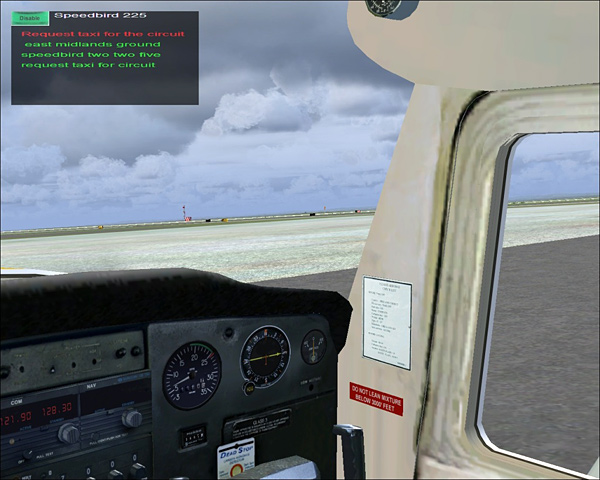
The first option, taxi for a local flight, is the option most
people will choose if they are intending to perform a simple,
routine flight that leaves the airport's airspace and then
either returns to it or lands elsewhere.
Pressing “0” on the keyboard will prompt the user to say:
Aircraft: XXX Ground YYY request taxi for local
(Where XXX = Station Name, and YYY = Aircraft's Callsign)
Once the request has been made, the ground ATC unit will
instruct the user to taxi to a specific runway, and will provide
any relevant airfield information (usually the airport's QNH and
runway in use).
After receiving an instruction to taxi to the runway; the user
should do so. Unlike default FSX, there is no “progressive taxi”
option; you must find the holding point using real-world charts
yourself! This is yet another good habit that VoxATC builds up
in its customers; in real-life there is no magical yellow arrow
that points to the holding point!
Unfortunately, I encountered a problem after receiving a taxi
command. Usually, one is handed off to the “Tower” frequency
before one reaches the holding point. Sometimes, however, I
found that VoxATC just forgot about me. The VoxATC communication
window simply said “taxi to holding point”, and even after I did
just that, still nothing happened.
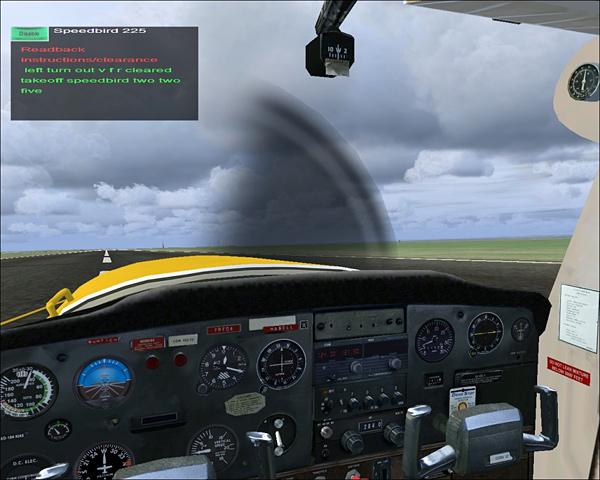
After an email to VoxATC's support, I received a swift reply
which resolved the issue. The trick was to open the “VoxATC
menu” by pressing the “0” key; this provided me with
an option to say the magical words “ready for departure”. Once I
said the phrase “ready for departure”, I was given an
instruction to transfer to the tower frequency.
Interestingly, this “issue” allowed me to discover another one
of VoxATC's little details. The phrase “ready for departure” is
one of the most important tuition points for RT students in the
UK. The
CAA have gone to enormous lengths to ensure that the word
“takeoff” is not used until an aircraft has been cleared to do
so by ATC; the phrase “ready for departure” tells ATC that an
aircraft is requesting a takeoff clearance.

So what? I hear you ask. Simply put, there is no such phrase as
“request takeoff clearance”. Using such words in an RT exam will
result in an instant fail (as it is a very, very important “pass
point”), since you are essentially breaking the rules listed in
the CAP413 document. Fortunately however, the VoxATC software
itself will not accept the phrase “request takeoff clearance” as
a substitute for “ready for departure”; more good habits!
It has to be noted however that "Ready for takeoff " is a permissible phrase as far as the FAA is concerned. Feedback from a commercial pilot in the USA confirms "Yes... once you've done your runup and taxied up to the hold line short of the runway... you call Tower and say "Cherokee 1205Tango runway 10 ready for takeoff" It's the proper procedure call to make.
Presently, VoxATC requires pressures to be read back in
“millibars”. As of 2012, the CAA has changed this so that the SI
unit “Pascals” (or more specifically, Hectopascals) should be
used. This change is going to be added to an up-coming release,
however, one millibar is
equal to one Hectopascal – hardly the most difficult unit
conversion!
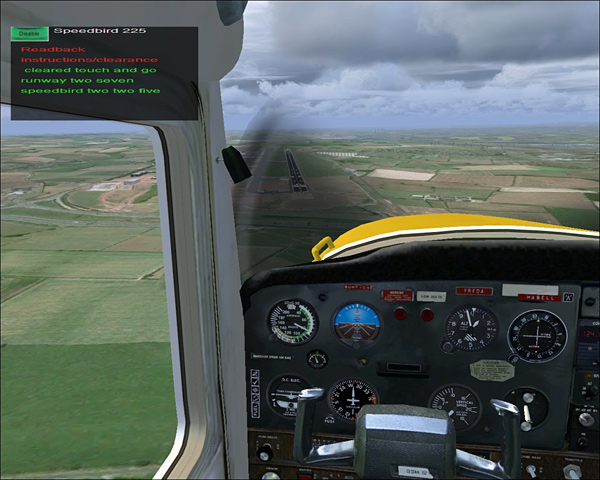
IFR Operations
Instrument Flight Rules, commonly abbreviated to IFR, are the
conditions under which pilots fly by when the weather is too
poor for visual flight. Most commercial “airline” traffic is IFR
(even when the weather is “good”), which allows them to fly
through Class A airspace; airspace that is restricted to all
non-IFR traffic.
VoxATC features all of the IFR ATC procedures used in real-life
daily flying. This means that VoxATC is extremely useful when
conducting an international flight in the PMDG737 or Level-D767,
since you can practice “heavy” procedures to whatever level of
detail you wish.
The vast majority of simulator jet pilots prefer to do their
online flying with VatSim or IVAO, since this offers the most
realistic IFR experience. There are, however, restrictions to
both networks, since air traffic controllers are not online all
of the time, which means that departure, arrival or even
en-route ATC is not always available.
VoxATC fills this gap by offering a realistic IFR environment
available any day of the week.
Creating and “Filing” a Flight
Plan
Whilst not compulsory under VFR conditions, a flight plan is one
of the most important aspects of IFR flight. The flight plan is
air traffic control’s “guide” for your flight, and tells them
who you are, where you are from, where you’re going, and what
type of aircraft you’re flying... The list goes on.
In order to issue you with instructions and headings that will
actually get you to your destination, ATC must obviously first
know some basic details (see above). For this very reason,
VoxATC allows the user to create and “file” a flight plan for
IFR flight, by which air traffic control will issue the user
with vectors and instructions.
Filing a flight plan is very simple. All one needs to do is
create a FSX flight plan file (.pln), and then save it to a
local folder. This flight plan should include all way-points and
altitudes that are to be used during the flight. Personally, I
recommend creating such a flight plan using the excellent
freeware “Plan-G” software, or a similar flight planning
program.
To fly IFR, one should have their IFR flight plan loaded prior
to pressing the “Initialise” button on the VoxATC window. If
this is done correctly, VoxATC will recognise that you intend to
fly IFR and will operate the flight accordingly.
Once a flight plan has been successfully loaded, you are ready
to fly IFR!
SIDs and STARs
Whilst there are many differences between IFR and VFR flight
using VoxATC, only the fundamental differences will be covered
here in detail. SIDs and STARs are one of these major
differences.
“SIDs” (Standard Instrument Departures) and “STARs” (Standard
Terminal Arrival Route) are a set of prepublished “directions”
for aircraft to follow when they are operating near an airport.
In order to keep traffic flow neat and efficient, aircraft
approaching Heathrow (for example) do not simply line up with
the runway and land. They must follow a “STAR”. The following
image shows the “Ockham” STAR to Heathrow.
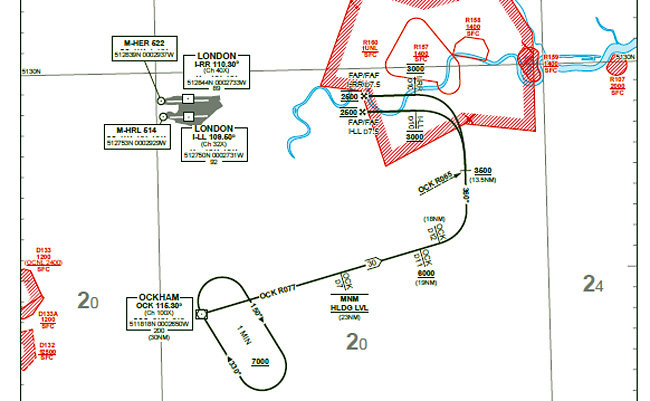
If you're wondering why the STAR is called “Ockham”, it is
because it uses the OCK VOR station (Ockham VOR) for
positioning; if you look closely, you can see that OCK is the
first VOR within the STAR.
SIDs are exactly the same; however they are published directions
for an aircraft to follow after takeoff from an airport.
SIDs and STARs are a fundamental part of IFR flight, wherever
you are in the world. As a result, VoxATC caters for extensive
use of SIDs and STARs.
The SID/STAR database is constantly updated in the real-world,
and this data is available for FS2004/FSX users from a site
called “Navigraph”. Unfortunately, these updates cost money and
so users that wish to remain up-to-date must pay real money
outside of their purchase of VoxATC. This is, however, beyond
the control of the VoxATC developers, since they do not own
Navigraph.
Thankfully, VoxATC includes a reasonable SID/STAR database as
standard. This database is the exact same one that is used in
the Level-D767's FMC software, so if you own the Level-D767
add-on, you will be familiar with the amount of SIDs/STARs
included with VoxATC.
When you are approaching an airport with an IFR flight plan
filed, VoxATC will (amongst passing you other instructions)
issue you with a STAR to follow. The STAR issued depends upon
which direction you are approaching the airport from (clearly,
it's a waste of time to execute an Eastern arrival if you are
arriving from the West).
The level of immersiveness provided by an ATC system that offers
SIDs and STARs is something that one simply cannot experience
with default FSX ATC.
The In-Flight Menu
Whilst VoxATC is intellegent, it cannot, of course, predict
exactly what you want to say. For example, if you're enroute
towards East Midlands, happily receiving a basic service, and
you experience an engine failure, you'll want to access a menu
that allows you to make the infamous “Mayday” call. VoxATC
cannot, of course, predict that you will have an engine failure,
so it is up to the user to have the “in-flight menu” at hand.
The in-flight menu is a selection of various calls that can be
made to air traffic control. Usually, VoxATC will provide
suggestions for the user in terms of what to do; for example,
when flying en-route, VFR, towards Gamston airport, the VoxATC
window might just say “continue flight” or something similar;
clearly not very useful if you want to make a Mayday call!
As a result, users can access the in-flight menu by pressing “0”
whilst en-route. This brings up a plethora of various calls that
can be made, including, but not limited to, Mayday (Distress
call), Pan-Pan (Urgency call), a position fix (ask ATC to
confirm your position), and so on. Real-world pilots will be
comfortable with using the in-flight menu, and it provides a
great training aid for student pilots; Mayday/Pan-Pan calls and
position fixes are often tested in the Radiotelephony practical
examination.
Although many paragraphs have been written regarding the
services one can receive through VoxATC, the actual feature list
is endless. Almost every single possible call one can think of
is covered somewhere along the line, each coded with its own
unique voice recognition parameters that won't activate unless
one says the correct words.
VoxATC Traffic
As previously mentioned, VoxATC is not just an ATC program. In
addition to providing everything you'll ever need, a complete
traffic system independent to that of FSX's traffic is provided
with the product.
Thankfully, VoxATC's traffic is as intelligent as you. They will
follow any procedure/instruction given to them by ATC, and they
behave exactly like real world traffic; that is, even when
flying out in the countryside seemingly by oneself, there will
always be some cheeky Cessna or misbehaving Mooney that pops out
of nowhere, only for ATC to save the day by advising the user of
the rouge aircraft's presence.
Likewise, should the user wonder too close to another aircraft,
ATC will “inform” the traffic that the user is nearby, and may
ask them to confirm a sighting of the traffic (in the exact same
way that a user would acknowledge traffic information).
Whilst VoxATC's traffic system is brilliant,
presently, one must ensure
that all FSX traffic is disabled. This is because VoxATC's
traffic listens to VoxATC; whilst default traffic will listen to
default ATC. Likewise, frequent collisions between the two are
imminent unless the latter is disabled.
VoxATC6 will normally use whatever third party programs are available such as Traffic X, My Traffic X and Ultimate Traffic via a bridge program. Although VoxATC 6 generates its own traffic, it does use the aircraft and liveries from the third party add-ons.
VoxATC's traffic is truly “intelligent”. As previously
mentioned, all AI aircraft will follow any instructions given to
them by ATC, which means that aircraft approaching Heathrow, for
example, will be arranged in the real world “stacks” when flying
towards the airport. This makes IFR procedural flying very
realistic, and when coupled with an in-depth aircraft simulation
(for example, the Level-D767), the level of immersiveness is
somewhat impressive.
VoxATC Extras
VoxATC includes a few impressive features that allow the user to
customize the experience to their liking. The “voice
configuration” program, located in VoxATC's installation folder,
allows users to change the voices of various ATC units, and the
voice of their first officer. American and British accents are
available for both males and females, and so the “monotonous”
nature of FSX's default ATC is somewhat displaced (since almost
all default ATC controllers sound like they are part of the same
family!).
There is also a “runway updater” program; also located in the
installation folder. Since the earth's magnetic field slowly
changes over time, runway headings become inaccurate every few
years or so. As a result, airports like to keep on top of this
issue and will rename their runway numbers when the heading has
drifted suitably. For example, Essex airport was forced to
change the runway named “23/05” to “22/04” in 2009, since the
earth's magnetic field had drifted by 10 degrees east.
VoxATC's runway updater is the software equivalent of airport
management. Using the latest AIRAC cycle (these are available as
payware updates from Navigraph's site, see the “SIDs/STARs”
section above), VoxATC is able to rename applicable runways for
a more realistic experience.
Also included is a “central taxiway lights removal” program.
This program, as the name suggests, will remove the green
central taxiway lights from whatever airport you want.
Personally however, I have chosen to keep my green taxiway
lights; I would feel somewhat lonely without them.
Documentation
An in-depth 80 page PDF manual is provided free of charge with
each purchase.
This manual easily guides a user through the basics, and
contains a mixture of tutorials and information. This is great
news, since most manuals these days are composed entirely of a
single tutorial, or just contain random stacks of information.
VoxATC's documentation will educate a user through its
tutorials, whilst at the same time provide a reference for
future use should you forget anything.
Future Updates
Bob Sidwick, owner of RC Simulations, has confirmed that
VoxATC6 is about to get a major update which has taken
around 6 months to develop, this will be free to existing
users. A vast amount of work has be done to improve the
logic of runway crossings and behaviour of AI aircraft, to
implement the change from change milibars to hectopascals
and much more besides.
Conclusion
VoxATC is a product that vastly improves an area of FSX that is
often overlooked. Whether one is simply looking for a more
realistic flying experience, or seeking a supplement to their
real-world training, this software ticks all of the boxes.
The product's strict tendency to keep perfectly in line with
real world law ensures that it is suitable for all enthusiasts;
real-world die hards and amateur FSX users will all find
something to keep themselves occupied with when there's nobody on
VatSim or IVAO.
The simply excellent traffic engine supplied with VoxATC
immerses the user in a busy traffic environment buzzing with
activity. Furthermore, the “intelligence” of the AI provided by
VoxATC ensures that you won't have anybody doing what they're
not supposed to do.
![]()
Verdict
Pros:
• Excellent realism – Real world procedures to a “T”
• Accurate voice recognition; will not accept false ATC
read-backs
• IFR and VFR services completely covered
• Traffic system is excellent

Cons:
• Occasional continuity problems with ground movements
Mutley's Hangar score of 10/10 and the Mutley's
Hangar Award for Excellence!
![]()
Jack
Whaley-Baldwin
Review machine Spec: Core i7 920 OC @ 3.8 Ghz |
6Gb Tri-Channel DDR3 Ram |GTX285 Graphics |Windows 7
64bit Home Premium

